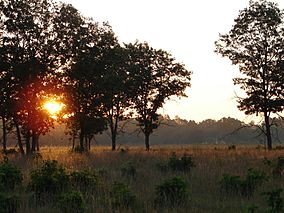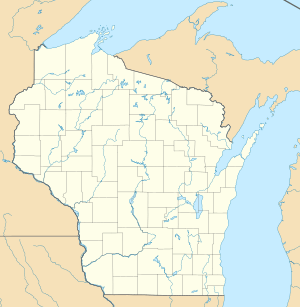Necedah National Wildlife Refuge facts for kids
Quick facts for kids Necedah National Wildlife Refuge |
|
|---|---|
|
IUCN Category IV (Habitat/Species Management Area)
|
|

Sunset on savanna at Necedah National Wildlife Refuge
|
|
| Location | Juneau County, Wisconsin, United States |
| Nearest city | Necedah, Wisconsin |
| Area | 43,696 acres (176.83 km2) |
| Established | 1939 |
| Governing body | U.S. Fish and Wildlife Service |
| Website | Necedah National Wildlife Refuge |
The Necedah National Wildlife Refuge is a special place in central Wisconsin, United States. It covers about 43,696 acres (or 177 square kilometers) of land. This refuge was created in 1939 to protect wildlife and their homes. It is especially known for helping to bring back the endangered whooping crane to the eastern United States.
Contents
Exploring the Refuge's Landscape
The Necedah National Wildlife Refuge is part of a very large wetland area called the Great Central Wisconsin Swamp. This swamp is the biggest bog in Wisconsin. A bog is a type of wetland that has a lot of peat, which is partly decayed plant material.
The refuge has many different types of natural areas. You can find large forests with pine, oak, and aspen trees. There are also big sections of rare oak barrens habitat. These barrens are open areas with scattered oak trees and lots of grasses and wildflowers.
Visiting the Refuge
Many people visit the Necedah National Wildlife Refuge each year. About 150,000 visitors come to enjoy nature. The refuge has a team of 13 people who work to manage and protect the area.
Visitors can do many fun activities here. You can go hunting and fishing in certain areas. It's also a great place to pick wild blueberries, blackberries, and raspberries when they are in season. The money needed to run the refuge often comes from selling timber from the forests.
Amazing Animals of Necedah
The Necedah National Wildlife Refuge is home to many different animals. It is especially important for several rare and endangered species.
Bringing Back the Whooping Crane
One of the most exciting projects at the refuge is helping the whooping crane (Grus americana). These tall, beautiful birds were once almost gone from the eastern United States. In 2001, a group called the Whooping Crane Eastern Partnership started a special program here.
They raised whooping crane chicks at the refuge. Then, they used ultra-light aircraft to teach the young cranes their migration path. The planes would fly from Necedah to the Chassahowitzka National Wildlife Refuge in Florida. The cranes learned to follow the planes, showing them the way south for winter. This amazing project has been very successful! By 2010, there were over 100 whooping cranes migrating in the eastern United States again. This was the first time in more than 100 years that so many cranes were seen there.
Other Rare and Migratory Species
Besides the whooping crane, the refuge protects other important animals. You might find the Karner blue butterfly, which is a small and beautiful butterfly that needs special habitats to survive. The massasauga rattlesnake, a rare type of snake, also lives here. Another special resident is the Blanding's turtle, known for its bright yellow chin. Sometimes, wolf packs can also be seen roaming the refuge.
The refuge is also a very important stop for many migratory waterfowl (birds that live near water) during their long journeys. These birds use the refuge as a resting and feeding spot along the Mississippi Flyway. The Mississippi Flyway is like a superhighway in the sky for birds, stretching from Canada all the way to the Gulf of Mexico.



